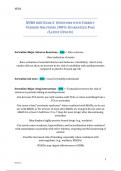NURS
NURS 660 EXAM 2 QUESTIONS WITH CORRECT
VERIFIED SOLUTIONS 100% GUARANTEED PASS
(LATEST UPDATE)
Sertraline Major Adverse Reactions - ANS ✓-Rare seizures
-Rare induction of mania
-Rare activation of suicidal ideation and behavior (suicidality) (short-term
studies did not show an increase in the risk of suicidality with antidepressants
compared to placebo beyond age 24)
Sertraline lab tests - ANS ✓none for healthy individuals
Sertraline Major drug interactions - ANS ✓-Tramadol increases the risk of
seizures in patients taking an antidepressant
-Can increase TCA levels; use with caution with TCAs or when switching from a
TCA to sertraline
-Can cause a fatal "serotonin syndrome" when combined with MAOIs, so do not
use with MAOIs or for at least 14 days after MAOIs are stopped,Do not start an
MAOI for at least 5 half-lives (5 to 7 days for most drugs) after discontinuing
sertraline
-May displace highly protein bound drugs (e.g., warfarin)
-Can rarely cause weakness, hyperreflexia, and incoordination when combined
with sumatriptan or possibly with other triptans, requiring careful monitoring of
patient
-Possible increased risk of bleeding, especially when combined with
anticoagulants (e.g., warfarin, NSAIDs)
-NSAIDs may impair effectiveness of SSRIs
1
NURS 660
,NURS
- Via CYP450 2D6 inhibition, sertraline could theoretically interfere with the
analgesic actions of codeine, and increase the plasma levels of some beta blockers
and of atomoxetine
-Via CYP450 2D6 inhibition sertraline could theoretically increase concentrations
of thioridazine and cause dangerous cardiac arrhythmias
-Via CYP450 3A4 inhibition, sertraline may increase the levels of alprazolam,
buspirone, and triazolam
-Via CYP450 3A4 inhibition, sertraline could theoretically increase
concentrations of certain cholesterol lowering HMG CoA reductase inhibitors,
especially simvastatin, atorvastatin, and lovastatin, but not pravastatin or
fluvastatin, which would increase the risk of rhabdomyolysis; thus,
coadministration of sertraline with certain ----HMG CoA reductase inhibitors
should proceed with caution
-Via CYP450 3A4 inhibition, sertraline could theoretically increase the
concentrations of pimozide, and cause QTc prolongation and dangerous cardiac
arrhythmias
-Via CYP450 3A4 inhibition, sertraline could theoretically increase the concen
Sertraline neurotransmitters and moa - ANS ✓-Boosts neurotransmitter
serotonin
-Blocks serotonin reuptake pump (serotonin transporter)
-Desensitizes serotonin receptors, especially serotonin 1A receptors
-Presumably increases serotonergic neurotransmission
-Sertraline also has some ability to block dopamine reuptake pump (dopamine
transporter), which could increase dopamine neurotransmission and contribute
to its therapeutic actions
Sertraline pregnancy risks - ANS ✓Not generally recommended for use during
pregnancy, especially during first trimester
Nonetheless, continuous treatment during pregnancy may be necessary and has
not been proven to be harmful to the fetus
At delivery there may be more bleeding in the mother and transient irritability or
sedation in the newborn
2
NURS 660
,NURS
Must weigh the risk of treatment (first trimester fetal development, third
trimester newborn delivery) to the child against the risk of no treatment
(recurrence of depression, maternal health, infant bonding) to the mother and
child
For many patients this may mean continuing treatment during pregnancy
Exposure to SSRIs early in pregnancy may be associated with increased risk of
septal heart defects (absolute risk is small)
SSRI use beyond the 20th week of pregnancy may be associated with increased
risk of pulmonary hypertension in newborns, although this is not proven
Exposure to SSRIs late in pregnancy may be associated with increased risk of
gestational hypertension and preeclampsia
Neonates exposed to SSRIs or SNRIs late in the third trimester have developed
complications requiring prolonged hospitalization, respiratory support, and tube
feeding; reported symptoms are consistent with either a direct toxic effect of
SSRIs and SNRIs or, possibly, a drug discontinuation syndrome, and include
respiratory distress, cyanosis, apnea, seizures, temperature instability, feeding
difficulty, vomiting, hypoglycemia, hypotonia, hypertonia, hyperreflexia, tremor,
jitteriness, irritability, and constant crying
Duloxetine (Cymbalta) Major Side Effects SNRI
commonly prescribed for: Major depressive disorder
•Generalized anxiety disorder
•Fibromyalgia
•Diabetic peripheral neuropathic pain (PDN) - ANS ✓Orthostatic hypotension
and syncope usually within the first week of use, constipation, dry mouth,
sweating, diarrhea, fatigue, loss of appetite, nausea, weight loss, hypertension,
headache, asthenia (abnormal physical weakness or lack of energy), dizziness,
insomnia, somnolence
*Try magnesium for constipation
Duloxetine (Cymbalta) Major Adverse Reactions - ANS ✓Serotonin syndrome
•Hepatotoxicity
•Rare activation of mania, depression, or suicidal ideation
3
NURS 660
, NURS
•Rare worsening of coexisting seizure disorders
Duloxetine Major Drug Interactions - ANS ✓CYP2D6 inhibitors (duloxetine,
paroxetine, fluoxetine, bupropion) cimetidine, and valproic acid can increase
drug concentration
•Concomitant use of potent CYP1A2 inhibitors (fluvoxamine, cimetidine,
quinolone antimicrobials [eg, ciprofloxacin, enoxacin]) should be avoided
•Serotonin release by platelets is important for maintaining hemostasis.
Combined use of SSRIs or SNRIs (such as duloxetine) and NSAIDs, and/or drugs
that affect anticoagulation has been associated with an increased risk of bleeding
•CYP2D6 and 1A2 enzyme inducers, such as rifamycin, nicotine, phenobarbital,
can lower levels
•May cause serotonin syndrome when used within 14 days of MAO inhibitors
•May increase risk of cardiotoxicity and arrhythmia when used with tricyclic
antidepressants vccccccccccccc
Duloxetine lab tests - ANS ✓check blood pressure at baseline and when
increasing dose
*Not recommended for patients with severe renal function impairment
(creatinine clearance less than 30mL/min) or end-stage renal disease
*Not recommended for patients with hepatic function impairment
Duloxetine neurotransmitters and moa - ANS ✓-Blocks serotonin and
noradrenergic reuptake pumps, increasing their levels within hours, but
antidepressant effects take weeks. ------Effect is more likely related to adaptive
changes in serotonin and norepinephrine receptors systems
•Weakly blocks dopamine reuptake pump (dopamine transporter)
Duloxetine pregnancy risk - ANS ✓-Category C. =Generally not recommended
for the treatment of headache or neuropathic pain during pregnancy. Neonates
exposed to duloxetine or other SNRIs or SSRIs late in the third trimester have
developed complications necessitating extended hospitalizations, respiratory
support, and tube feeding. Respiratory distress, cyanosis, apnea, seizures,
temperature instability, feeding difficulty, vomiting, hypoglycemia, hypotonia,
4
NURS 660




